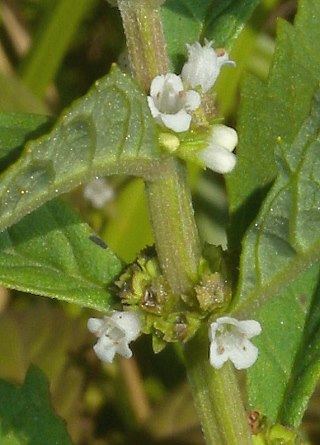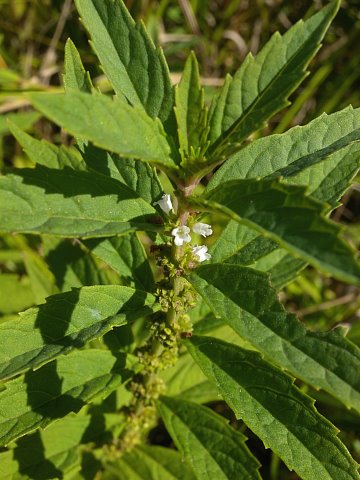 green and hairless to
short-pubescent. Sometimes, the leaves become purplish green in bright
sunlight. Dense whorled clusters of nearly sessile flowers occur above
the axils of the middle to upper leaves. Each flower is about 1/8" (3
mm.) in length; it consists of light green calyx with 4-5 teeth, a
white corolla with 4-5 tiny lobes, 2 slightly exerted stamens, and a
pistil. The toothed calyx is 0.5-1 mm. in length; its teeth are broadly
triangular. The corolla is 2.5-3.5 mm. in length; it is campanulate
(bell-shaped). The blooming period occurs from mid-summer into the
fall, lasting 2-3 months. Usually, only a few flowers are in bloom at
the same time. Afterwards, each flower is replaced by 4 nutlets. The
nutlets are 1.0-1.5 mm. long, obovoid, and 3-angled; the apex of each
nutlet is tuberculate (bumpy) along the outer side, while
the inner sides are flat and depressed. Taken together, the upper
surface of each group
of 4 nutlets forms an indented central area and a bumpy
exterior. The root system
is stoloniferous and tuberous. Clonal colonies of plants are often
formed.
green and hairless to
short-pubescent. Sometimes, the leaves become purplish green in bright
sunlight. Dense whorled clusters of nearly sessile flowers occur above
the axils of the middle to upper leaves. Each flower is about 1/8" (3
mm.) in length; it consists of light green calyx with 4-5 teeth, a
white corolla with 4-5 tiny lobes, 2 slightly exerted stamens, and a
pistil. The toothed calyx is 0.5-1 mm. in length; its teeth are broadly
triangular. The corolla is 2.5-3.5 mm. in length; it is campanulate
(bell-shaped). The blooming period occurs from mid-summer into the
fall, lasting 2-3 months. Usually, only a few flowers are in bloom at
the same time. Afterwards, each flower is replaced by 4 nutlets. The
nutlets are 1.0-1.5 mm. long, obovoid, and 3-angled; the apex of each
nutlet is tuberculate (bumpy) along the outer side, while
the inner sides are flat and depressed. Taken together, the upper
surface of each group
of 4 nutlets forms an indented central area and a bumpy
exterior. The root system
is stoloniferous and tuberous. Clonal colonies of plants are often
formed.Cultivation: The preference is full or partial sun, wet to moist conditions, and soil that is sandy, loamy, or marly.
Range & Habitat: The native Northern Bugleweed is occasional in the northern half of Illinois, while in the southern half of the state it is rare or absent (see Distribution Map). Generally, Northern Bugleweed has a more northern distribution in North America than most species in its genus. Habitats include marshes, fens, low areas along pools of water, streambanks, and swamps. These habitats include both sandy and non-sandy wetlands. Should a wildfire occur, this wildflower can regenerate itself through the stolons and tubers of its root system.
Faunal Associations: The small flowers are cross-pollinated by a variety of insects, including long-tongued bees, short-tongued bees, wasps, and flies. Most of these floral visitors suck nectar, although some bees and flies may use the pollen as a food source. Small butterflies and skippers are less typical visitors of the flowers. Among vertebrate animals, muskrats consume the tubers of Northern Bugleweed and other Lycopus spp. with tuberous root systems. Generally, the foliage is not attractive to mammalian herbivores because of its bitter taste. In addition, the foliage is probably somewhat toxic to them if it is eaten in quantity.

Photographic Location: Along a sandy marsh at the Heron Boardwalk in Vermilion County, Illinois.
Comments: Northern Bugleweed is a fairly typical example of the Lycopus spp. that occur in Illinois. Its calyx can be distinguished from those of similar species by its short length (1.0 mm. or less) and broad teeth. Other Lycopus spp. within the state have longer calyces with narrow teeth. An exception is Lycopus virginicus (Virginia Bugleweed), which has the same type of calyx. This latter species, however, has leaves that taper abruptly toward their bases, rather than gradually, and its leaf margins have more abundant smaller teeth. The root systems of these two species are also somewhat different: Northern Bugleweed usually produces tubers, while Virginia Bugleweed lacks such tubers.